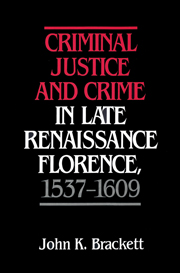Book contents
- Frontmatter
- Contents
- Acknowledgments
- Introduction
- 1 The bureaucratic structure of the Otto: the personnel and their functions
- 2 Financing the Otto
- 3 The Otto as police: organization and function
- 4 Criminal procedure before the Otto: from discovery to sentencing
- 5 The Otto and its role in the centralization of criminal justice in the Florentine state
- 6 Crime and criminals
- Conclusion
- Appendix 1 Names of other officers of the Otto di Guardia e Balìa, 1537–1609, as we have them
- Appendix 2 Budget totals by year
- Appendix 3 Comparison of detailed average expenditures for budgets, 1537–1547 and 1598–1609
- Appendix 4 Occupation key
- Bibliography
- Index
4 - Criminal procedure before the Otto: from discovery to sentencing
Published online by Cambridge University Press: 05 September 2009
- Frontmatter
- Contents
- Acknowledgments
- Introduction
- 1 The bureaucratic structure of the Otto: the personnel and their functions
- 2 Financing the Otto
- 3 The Otto as police: organization and function
- 4 Criminal procedure before the Otto: from discovery to sentencing
- 5 The Otto and its role in the centralization of criminal justice in the Florentine state
- 6 Crime and criminals
- Conclusion
- Appendix 1 Names of other officers of the Otto di Guardia e Balìa, 1537–1609, as we have them
- Appendix 2 Budget totals by year
- Appendix 3 Comparison of detailed average expenditures for budgets, 1537–1547 and 1598–1609
- Appendix 4 Occupation key
- Bibliography
- Index
Summary
The reform of criminal procedure was an important issue in early modern Tuscany that Florence's grand dukes, especially Cosimo I, did not hesitate to address. Cosimo hoped to provide himself with a smoothly functioning system of social control. Thus, as befit his chosen image of Caesar Augustus, Cosimo I would have been able to claim a starring role in the revival of traditional values, among which was the renewal of justice. As is all too often the case, however, the clarion call for judicial reform obscured baser motives: Cosimo's reforms were actually aimed at creating profits. These were to be realized through shortened procedures that were to reduce costs and save time and, where possible, the swift imposition primarily of monetary penalties.
The success of Tuscan reform can be assessed from the trial procedures followed by the Otto di Guardia in the adjudication of criminal causes, the modes of initiation, the role of the court in advancing a case to the sentence, and the structure and enactment of penalties. An analysis of the criminal procedure followed by this important and powerful tribunal during the early modern period in Italy can also elucidate the ways in which the technical and fiscal limits placed on the system (so that it might produce profits) actually helped to shape the Eight's character.
The Otto began as an executive commission with great powers of investigation and arrest in the limited area of state security.
- Type
- Chapter
- Information
- Publisher: Cambridge University PressPrint publication year: 1992
- 1
- Cited by



